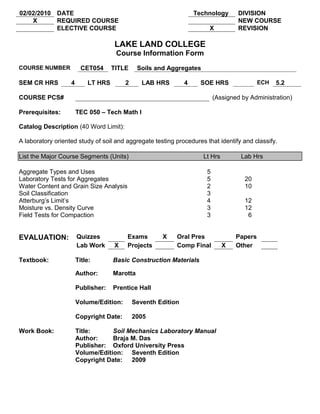Cetgdtfdgdd
- 1. 02/02/2010 DATE Technology DIVISION X REQUIRED COURSE NEW COURSE ELECTIVE COURSE X REVISION LAKE LAND COLLEGE Course Information Form COURSE NUMBER CET054 TITLE Soils and Aggregates SEM CR HRS 4 LT HRS 2 LAB HRS 4 SOE HRS ECH 5.2 COURSE PCS# (Assigned by Administration) Prerequisites: TEC 050 ¨C Tech Math I Catalog Description (40 Word Limit): A laboratory oriented study of soil and aggregate testing procedures that identify and classify. List the Major Course Segments (Units) Lt Hrs Lab Hrs Aggregate Types and Uses 5 Laboratory Tests for Aggregates 5 20 Water Content and Grain Size Analysis 2 10 Soil Classification 3 AtterburgˇŻs LimitˇŻs 4 12 Moisture vs. Density Curve 3 12 Field Tests for Compaction 3 6 EVALUATION: Quizzes Exams X Oral Pres Papers Lab Work X Projects Comp Final X Other Textbook: Title: Basic Construction Materials Author: Marotta Publisher: Prentice Hall Volume/Edition: Seventh Edition Copyright Date: 2005 Work Book: Title: Soil Mechanics Laboratory Manual Author: Braja M. Das Publisher: Oxford University Press Volume/Edition: Seventh Edition Copyright Date: 2009
- 2. Major Course Segment Lt. / Lab Hours Learning Outcomes Students will be able to: Aggregates Aggregate uses 3/0 understand uses of different aggregates Aggregate types 3/0 Identify types of aggregates Aggregate production 3/0 List methods of aggregate production Aggregate gradation 2/10 Perform an aggregate gradation Coarse aggregate specific gravity 1/5 Perform a coarse aggregate specific gravity Fine aggregate specific gravity 1/3 Perform a fine aggregate specific gravity Fine aggregate fineness modulus 1/2 Perform a fine aggregate fineness modulus Soils Water content 1/2 Calculate a water content of a soil Grain size Analysis 2/8 Identify the %ˇŻs of sand, silt & clay Soil Classification 2/0 Use I.D.H. & A.A.S.H.T.O. charts to classify soil types Liquid Limit 2/4 Perform and calculate liquid limit Plastic limit 1/4 Perform and calculate plastic limit Plasticity Index 1/4 Calculate plasticity index Proctor Curve 2/8 Perform and calculate a proctor curve Hydrometer 2/6 Perform and calculate hydrometer results Specific Gravity 1/3 Perform a soil specific gravity Field Compaction 2/1 Nuclear Density Test of soil
- 3. Course Learning Outcomes: at the successful completion of this course, students will be able to: 1. Perform the duties necessary to be an Aggregate Technician within industry 2. Demonstrate proper testing procedures of aggregates in the laboratory 3. Complete documentation necessary for aggregate testing 4. Compile documentation including the equipment, methods, and purpose for soil testing as related to Civil Engineering projects. Learning Outcome Method : 1. 70% of the class will score an 80% or higher on Illinois Department of TransportationsˇŻ Mixture Aggregate Technician Course Written Exam. 2. 95% of the class will score a ˇ°Passˇ± on a Pass/Fail laboratory exam administrated by IDOT QC/QA instructors. 3. 70% of the class will score an 80% or higher on a calculations exam administrated by IDOT QC/QA instructors. 4. 70% of the class will score 80% or higher on a written SoilˇŻs Lab Report encompassing all soil tests performed in the class lab time.



